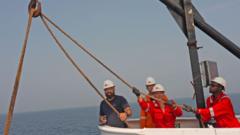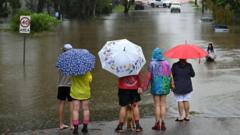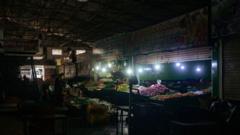**The Léon Thévenin serves as a vital force in restoring undersea internet cables, facing the challenges of a continent increasingly reliant on digital services.**
**Africa's Lifeline at Sea: The Ship Keeping Internet Connectivity Afloat**

**Africa's Lifeline at Sea: The Ship Keeping Internet Connectivity Afloat**
**A deep dive into Léon Thévenin's crucial role in maintaining Africa's internet infrastructure.**
In the vast expanse of the African coastline, a formidable vessel awaits to uphold the digital lifeblood of millions. The Léon Thévenin, a ship stretching the length of a football field and manned by over 50 skilled engineers and technicians, operates tirelessly to combat the fading digital links across Africa. The necessity of this mission became glaringly evident when internet cables beneath the ocean were damaged last year, causing a cascade of outages from Lagos to Nairobi, affecting everything from messaging services to vital banking transactions.
Recent on-board coverage from a BBC team has spotlighted the ship's 13-year commitment to repair undersea cables that, once severed, plunge regions into technological darkness. "Because of me, countries stay connected," says Shuru Arendse, a proud South African cable jointer. His dedication resonates through the diverse crew aboard, all committed to ensuring the continent's online networks remain intact.
At the core of the internet's infrastructure lies a complex web of undersea fibre optic cables, designed to function efficiently for up to 25 years. While they generally withstand the elements, human activities often pose the greatest threat. "Most of the time, it's people anchoring where they shouldn't and fishing trawlers potentially causing damage," explains Charles Heald, an authority on the ship's remotely operated vehicles (ROVs).
The urgency of repairs amplifies with each disturbance, as seen in the recent severing of three major cables in the Red Sea, which disrupted connectivity for millions. Natural disasters also contribute to cable damage, particularly in storm-prone areas. With a vast network of cables connecting coastal cities to global data centers, the stakes couldn't be higher.
The crew employs various techniques to identify and repair faults. With a ROV capable of functioning at depths beyond 5,000 meters, the ship is equipped to handle damages that local teams cannot. The process is intricate, requiring the pinpointing of faults via electrical signals before the ROV is deployed to cut and splice the damaged sections, restoring connectivity.
While the technical aspects of the job are profound, the emotional toll on crew members is equally significant. Many express personal sacrifices made for the sake of their careers. "I wanted to quit. It was difficult to stay away from my family, but my wife encouraged me," shares Adrian Morgan, a South African chief steward. Others express concerns over missing significant life events, revealing the shared camaraderie and hardships among the crew.
The Léon Thévenin represents more than just a vessel; it embodies hope and resilience for a continent that increasingly relies on internet connectivity for economic and social progress. "We are the link between Africa and the world," emphasizes chief engineer Ferron Hartzenberg, highlighting the essential role of the ship's mission.
As the world moves deeper into digital interconnectedness, the importance of the Léon Thévenin will only grow, reinforcing its position as a hero among heroes savouring the triumph of communication over adversity.



















